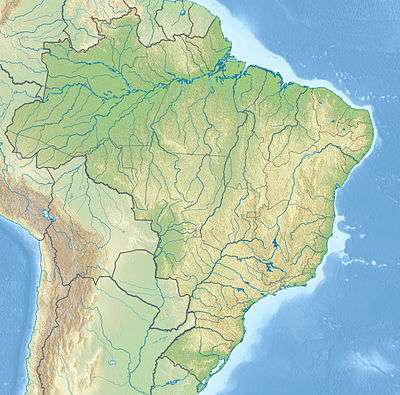Castanheiras Pied Tamarin Wildlife Refuge
| Castanheiras Pied Tamarin Wildlife Refuge | |
|---|---|
| Refúgio da Vida Silvestre Sauim Castanheiras | |
|
IUCN category IV (habitat/species management area) | |
 Location in Brazil | |
| Nearest city | Manaus, Amazonas |
| Coordinates | 3°05′27″S 59°55′33″W / 3.0908°S 59.9259°WCoordinates: 3°05′27″S 59°55′33″W / 3.0908°S 59.9259°W |
| Area | 95 hectares (230 acres) |
| Designation | Ecological Reserve |
| Created | 12 August 1982 |
The Castanheiras Pied Tamarin Wildlife Refuge (Portuguese: Refúgio da Vida Silvestre Sauim Castanheiras), formerly Castanheiras Pied Tamarin Ecological Reserve, is a wildlife refuge in the municipality of Manaus, Amazonas, Brazil. It was created in 1982 to protect a colony of pied tamarins.
Foundation
The Reserva Ecológica de Sauim-Castanheiras was created by Presidential Decree 87.455 on 12 August 1982 with an area of 109.2 hectares (270 acres).[1][2] The reserve was located in the Industrial District on the outskirts of the Manaus Free Zone. The purpose was to protect populations of pied tamarins (Portuguese: Sauim, Saguinus bicolor) and Brazil nuts (Bertholletia excelsa).[3]
The wildlife refuge today occupies 95 hectares (230 acres). From 2001 it was managed by the Municipal Office of the Environment and Sustainability (Secretaria Municipal de Meio Ambiente e Sustentabilidade, Semmas) for the Manaus Prefecture.[4] It became part of the Central Amazon Ecological Corridor, established in 2002.[5] The refuge has access roads, administrative buildings, a kitchen for food preparation for animals, an autopsy building, a veterinary centre with inpatient rehabilitation structures and grounds.[6]
Activities

5: Castanheiras Pied Tamarin Wildlife Refuge
The wildlife refuge contains a Wild Animal Screening Centre (CETAS) and an Animal Rescue Service. These help wild animals that are threatened by risks such as habitat loss, domestic abuse, accidents and other problems. A veterinarian examines the animal and treats it if necessary. Where practical it is restored to nature. Otherwise it may be allocated to a zoo or other institution. The refuge is not open to the public.[4]
Notes
Sources
- Áreas Protegidas (in Portuguese), Semmas, retrieved 2016-04-20
- CEC Central da Amazônia (in Portuguese), ISA: Instituto Socioambiental, retrieved 2016-10-17
- Mário David Andreazza (12 August 1982), DECRETO Nº 87.455, DE 12 DE AGOSTO DE 1982 (in Portuguese), retrieved 2016-04-20
- "Refúgio da Vida Silvestre Sauim Castanheiras", No Amazonas é Assim (in Portuguese), retrieved 2016-04-20
- RESEC Sauim-Castanheira (in Portuguese), ISA: Instituto Socioambiental, retrieved 2016-10-20
- Reserva Ecológica Sauim Castanheira (in Portuguese), ViaRural, retrieved 2016-04-20